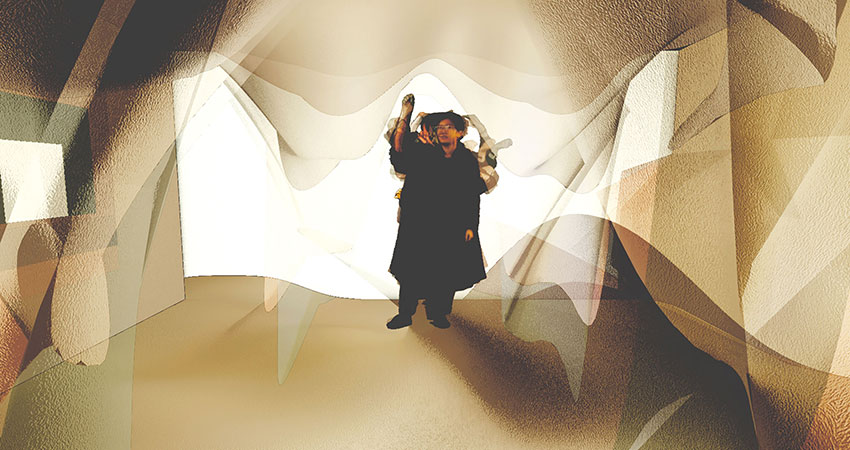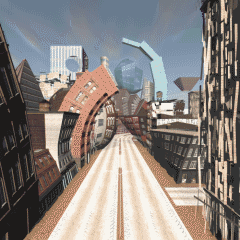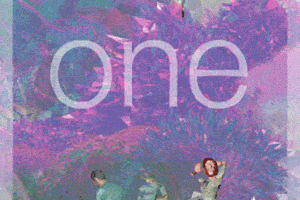Text by Adriana Ciotau

New technologies can impact how architects create an experience in architecture by pushing its boundaries. Architect Aimee Aizhen Chen’s practice focuses on researching the spatial qualities of immersive technologies (XR). Looking at the material, the immaterial and the overlap between the two. The in-between spaces.
In the immersive XR experiences, there is a need to design the entire environment, choreography, atmosphere and the ‘avatar’; this means that the architect is faced with addressing a whole experience that goes beyond just shaping a physical structure. It demands a different way of understanding architecture. The architect asks himself how he designs and how does he conceptualize experience in a way that can be reproduced in immersive (XR) space.
Aimee Aizhen Chen is working on XR’s potential to replace material objects and enhance immaterial values as one of the key solutions for the climate and resource crisis. Aimee perceives immersive technologies as a way to create opportunities to redesign society: Adapting the existing and creating new structures of organizations.
The interest in ‘self-manifestation’ as an architect in the digital age can be traced throughout her research practice. For Aimee, the ‘self-manifestation’ act represents the act of discovering, challenging and reinventing the self in order to understand the mind. And she goes further; it is essential in order to steer a path to the future where the interaction with the physical and virtual world is enviable.
The role of an architect can be questioned in the digital age; as Aimee states for a very long time, architects have been perceived as designers of the built environment. Now, however, this built environment is extended into the virtual world. Video games, virtual gatherings or even navigating the smartphone are examples of existing immersive environments. There is an urgent need for architects to embrace digital technologies not just as a design tool, but rather as a new dimension for self-manifestation.
The Modelling in Virtual Environment project is part of the architecture research and it’s imaging the influence of VR or AR technology in the future of architecture; challenging the representation and perception of design, shifting from 2D to spatial thinking.



During this research, Aimee conducted a study into the history of architectural representation and speculated how XR technologies further improve the quality, value, or extent of representation. Thus, enabling the discovery of something that has never been seen before. One thing that has intrigued Aimee for years is the spatial creation of our reality. Architects have a tangible notion of designing the physical space. Also, architects are aware of the spatial experience that extends to feelings, memories, and intangible ideas, and the different experiences of individuals.
Being surrounded by a culture of investigation and experimentation (it wasn’t until she decided to study at the Architectural Association in London, where she was taught by Lara Lesmes and Fredrik Hellberg (Founders & Directors of Space Popular)), that she started realising the potential of immersive technologies like virtual reality (VR) and augmented reality (AR) as an immersive enhancement of the physical world. There is a reliance on the surface of our computer screen or on drafting paper to compose and create. Therefore, our perception or mental image is constructed by 2D images.
Modelling in Virtual Environment demonstrates the possibility of designing or modelling architectural space in a virtual environment (3-D immersive space enabled by VR technology). Aimee Aizhen Chen continues: Virtual environments created through immersive technology can liberate us to the point of true expression.
For the first time in history, we will no longer need to compress our ideas through a medium. Take an infant as an example. Infants are not born to knowing how to speak, write, or draw. Nevertheless, we understand them based on their paralanguage, which surpasses the medium of the spoken language. It is our deepest desire to surpass the traditional medium, to live and communicate in space freely.
The Proposed Communication Tool research does not just apply to the discipline of architecture but rather challenges the human desire to connect with others through heightened communication feedback loops. Whether you are ready or not, we are currently in a paradigm shift. A paradigm shifts towards spatial dimensional thinking in a more immaterial world. It is as impactful as the invention of perspective by Alberti during the advancement of scientific discoveries, Aimee states.
Aimee participated as an artist to RETEK 2019 edition, a crafting colony at Satu-Mare, on the border of Romania and Hungary. For me, it was the experience of one-week community living with diverse creative individuals who are passionate about their discipline and hungry to explore unknown fields. The site was quirky and perfect to stimulate creativity. Imagine an abandoned furniture factory and ex-rabbit farm filled with random and incomprehensible things everywhere, Aimee states.
The theme of the 2019 edition was ‘shapeshifting’, a mythical term describing the ability of specific creatures transformation into animals or humans. In her workshop, Aimee builds on the research on communication in a virtual environment. The participants were challenged to move beyond their traditional limits and transform themselves into digital form. Thereby constantly shifting perspectives to question the human and object relation.
Till now, HUMAN 2.0 has been a paradigm. Neil Sahota wrote that Human 2.0 is coming faster than we think. Becoming aware of the shifting from human to Human 2.0 and how architects perceive it is what Aimee Aizhen Chen’s workshop at the RETEK focused on. Aimee Aizhen Chen perceived HUMAN 2.0 as ‘an enhanced version of the self; a digital manifestation.’
There is a new interaction between human and virtual space, where human gets another value and here comes HUMAN 2.0. (Modelling in Virtual Environment).
As Aimee explains, human beings can shift the form of objects, and in return, the objects shift us. It is a constant dialogue between us and objects, an unacknowledged language within our DNA. We have all come across some object in our life of which we cannot comprehend its form or function. We play with it in our hands to examine it and relate it to what we know. There comes a point, an aha moment, or a great idea. It can be a cup, a chair or a building. So, the next time we see something resemble it, we know what it is and what it can be. This is the concept the participants adopted, using 3d scanning of objects that they found attracted to them on the site, then remaking themselves in 3d modelling software by doing the exercise of shifting between the embodied digital self and seeing it as an object in our material world to understand their human-object relation.
Architects have traditionally not been involved in the design process of the XR environments. Our perceived reality consists of both physical and virtual environments together. Therefore, there is an urgent need for architects to embrace digital technologies not just as a design tool but rather as a new dimension for self-manifestation. Architects are becoming ‘the technologist’ who are deeply aware of the tools they are using. We give another value to the architect.






